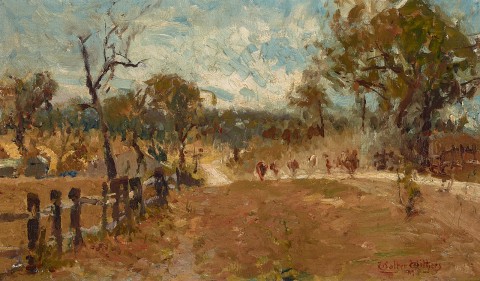THE HOT ROAD, c.1895 – 97
WALTER WITHERS
oil on canvas on board
29.0 x 49.0 cm
signed lower right: Walter Withers / M
bears inscription verso: Lent by Margery WITHERS, 1962 V.A.S / To go to Mary Roberta Owen / 52 Staughton Rd / Glen Iris / … / signature Margery McCann / ‘nee Withers / September 18th 1958
bears inscription on old label verso: NTH-EAST HEIDELBERG ROAD / “THE HOT RD” OLD ELTHAM ROAD / NOW NAMED, ROSANNA ROAD / Painted by WALTER WITHERS about / 1895 to 97 whilst resident of CAPE ST / IN THE POSSESSION OF HIS DAUGHTER / MARGERY WITHERS, OF 101 THE BOULEVARD, IVANHOE N21. / Mrs. R. McCANN, ARTIST. U.X.2344
Margery McCann née Withers (1894 – 1966), Melbourne, daughter of the artist
Thence by descent
Mary Roberta Owen OAM (1921 – 2017), Melbourne, her niece
Thence by descent
Private collection, Victoria
Archives Exhibition, Victorian Artists’ Society, Melbourne, November 1962, cat. 35 (lent by Margery Withers)
Annual Collectors Exhibition 2002, Holmes à Court Gallery, Perth, 20 September – 20 October 2002; Lauraine Diggins Fine Art, Melbourne, 1 November – 14 December 2002, cat. 8 (illus.)
Mackenzie, A., Walter Withers: The Forgotten Manuscripts, Australian Art Manuscripts Series, Mannagum Press, Melbourne, 1987, p. 52 (illus.)
The brush strokes in Walter Withers’ The Hot Road, c.1895 – 97 pulsate with heat. The air is full of it. As a radiant part of the Australian landscape, Withers was not alone in its depiction. Arthur Streeton paid it poetic tribute in ‘The purple noon’s transparent might’, 1896 (National Gallery of Victoria, Melbourne). Taking the title from a poem by Shelley, he wrote to Tom Roberts that he painted it ‘during a shade temperature of 108 degrees’.1 Summer atmosphere and dusty roads appealed greatly to the Australian Impressionists. Both were going places. While Roberts showed a preference for the city, as in Allegro Con Brio, Bourke Street West, c.1885 – 86 (National Gallery of Australia, Canberra), Streeton’s was for country tracks before others led him to London. Significantly, Streeton’s The Australian Road, 1896 (private collection, Melbourne) – a road leading to Kurrajong in New South Wales – was also known as The Hot Road.2 Throughout Withers’ landscapes of storms, farms and beaches, there are many road scenes, often peopled with men carrying their swags, women, carts, horses and cattle, as in A Bright Winter’s Morning, 1894 (National Gallery of Victoria), Early Morning, Heidelberg, 1898 (Art Gallery of South Australia) and The Drover,1912 (Bendigo Art Gallery, Victoria).
Withers was born in Warwickshire, far from the home in Cape Street, Heidelberg, where he and his wife Fanny settled in 1894. The climate was dramatically different. And it was here, many agree, that he painted some of his finest works, from smaller, engaging atmospheric studies, as in our The Hot Road, to the major compositions such as Tranquil Winter, 1895, purchased the same year by the National Gallery of Victoria. His stature as a landscape painter of considerable note was confirmed when, in 1897, he won the first Wynne Prize for the best landscape painting of the year with The Storm, 1896 (Art Gallery of New South Wales, Sydney). He was awarded the prize again in 1900 with Still Autumn.
A description of Withers’ approach to The Coming Storm, 1898 (also titled The Rising Storm) in the Art Gallery of Ballarat, Victoria written by his wife Fanny, gives insight into our painting: ‘… a dramatic painting, executed rapidly during the short interval between the threatening, and the actual visitation of the tempest. It is accounted one of the finest rapid pieces of work, which Walter Withers ever executed. It has the boldness and vigour of a quickly executed sketch with the masterly finish of an accomplished and inspired hand’.3 The Hot Road and The Coming Storm share an immediacy that comes from the spontaneity of their execution, leading to increased empathy between subject, artist and viewer. In The Hot Road the two walking figures are barely visible, illusions almost dissolved by the heat as the cattle move into the picture and raise the dust. As Fanny observed, it was not a passing interest, ‘Withers was something of a salamander and could sit in the open painting with the thermometer at 110° [F] in the shade’.4 It did not escape his contemporaries’ notice. When, in 1891, Withers exhibited A Hot and Dusty Road, acknowledged as among the best in his solo show, a Melbourne writer observed, ‘That is a thing we in Australia understand. The picture is so realistic that one grows hot and uncomfortable looking at it’.5
1. Percy Bysshe Shelley, Stanzas Written in Dejection, near Naples. Arthur Streeton to Tom Roberts, Tom Roberts Correspondence, MS A 2480, vol. 1, Mitchell Library, State Library of New South Wales.
2. Smith, G., Arthur Streeton 1867-1943, exhibition catalogue, National Gallery of Victoria, Melbourne, 1995, p. 118
3. Withers, F., The Life and Art of Walter Withers, Alexander McCubbin, Melbourne, 1920, pp. 22 – 23
4. Mackenzie, 1987, p. 123
5. The Evening Standard, 16 May 1891, quoted in Mackenzie, p. 139
DAVID THOMAS
